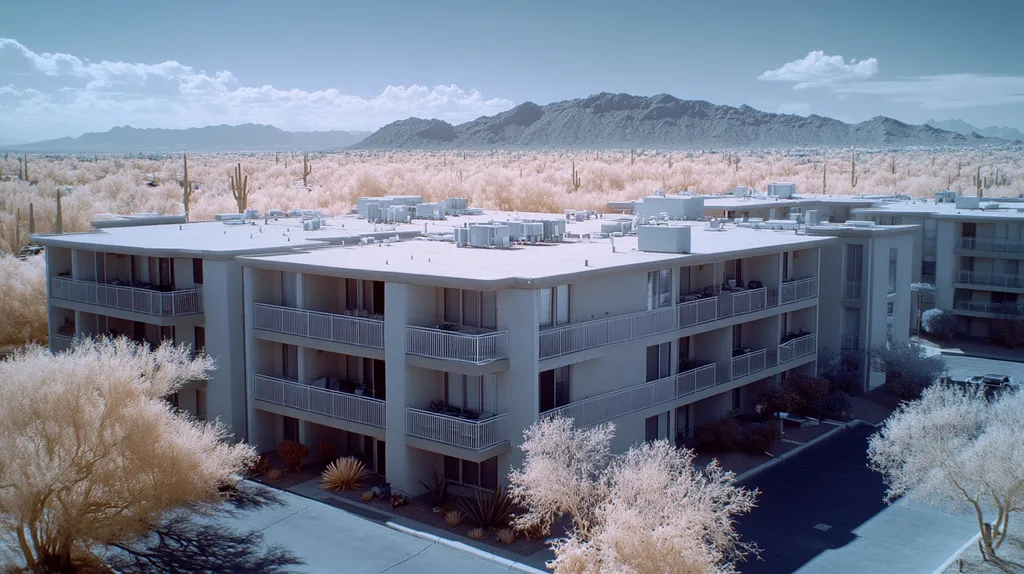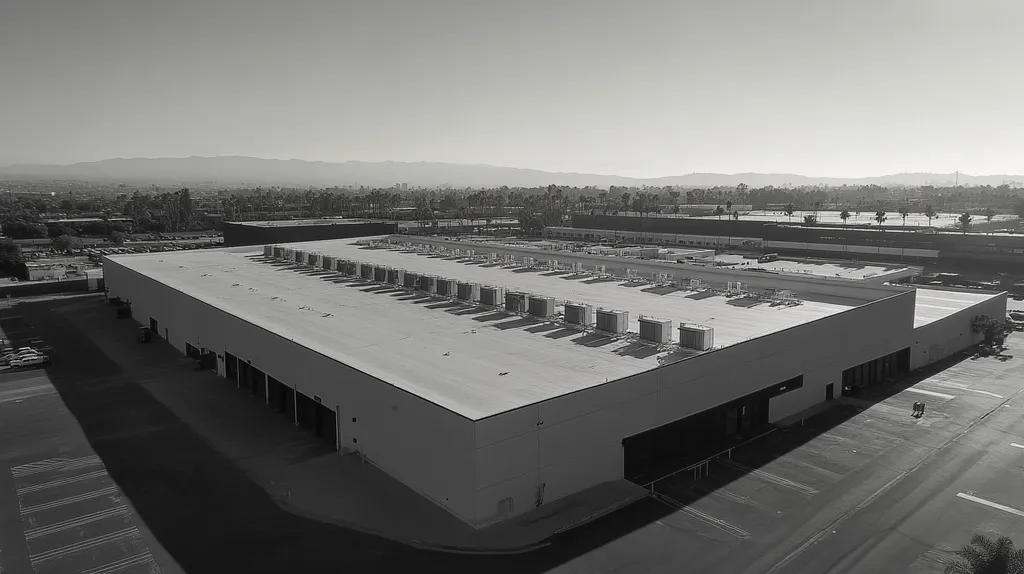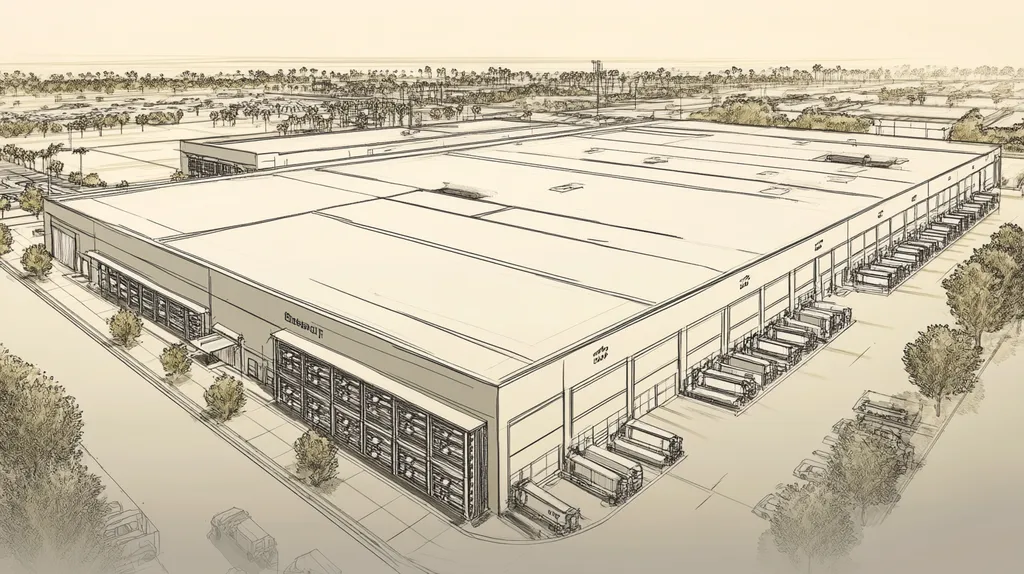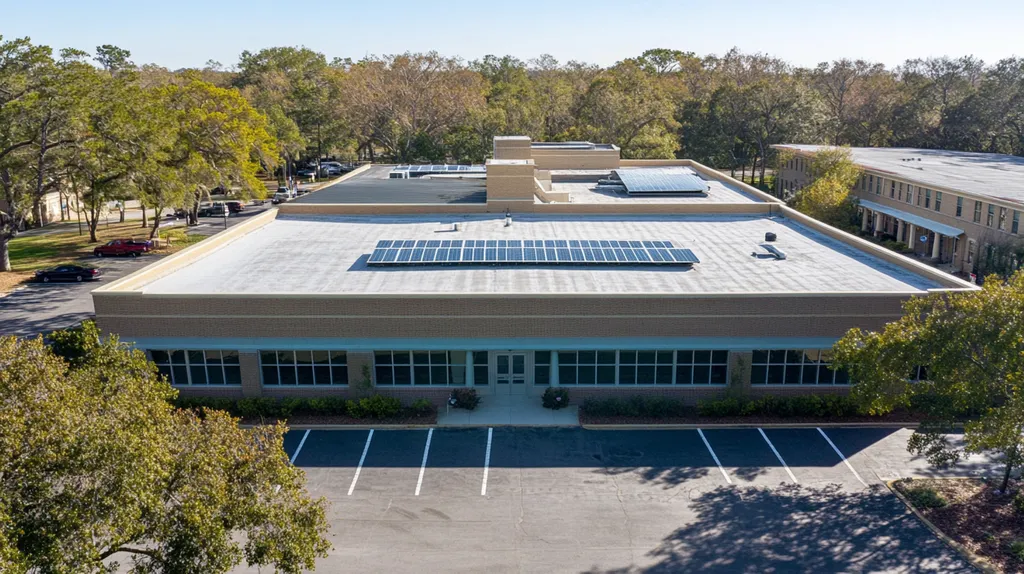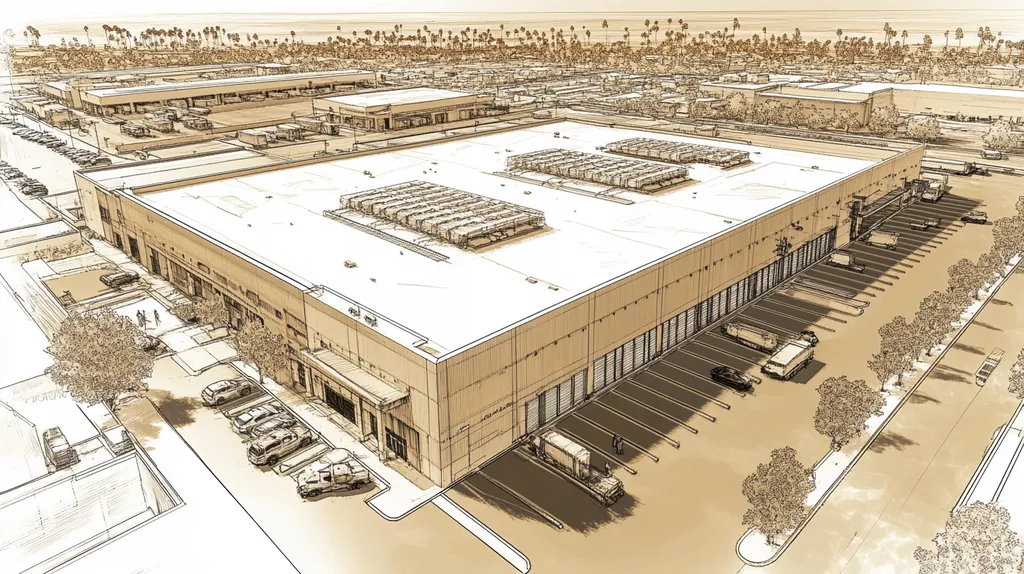Industrial roof failures cost U.S. businesses over $3.5 billion annually in repairs, lost productivity, and damaged inventory. Despite these staggering losses, standard replacement recommendations often overlook critical systemic issues within the industry.
From inadequate contractor qualifications to conflicts of interest in material specifications, the current approach to roof replacement decisions requires urgent reform.
This analysis examines how conventional recommendations fall short, exploring assessment oversights, material limitations, and installation compliance issues that compromise industrial roofing outcomes.
SECTION 1: CURRENT PRACTICES
Industrial roof management is a critical concern, as nearly 30% of industrial facilities experience unexpected roof failures each year. Such failures can result in significant downtime, expensive repairs, and safety hazards. However, many facility managers often recommend quick repairs or patching, neglecting the importance of a comprehensive roof replacement. This section highlights frequent oversights in assessment and planning, material selection, and installation procedures that can undermine roof performance.
Assessment and Planning Oversights
An effective approach to roof management starts with a thorough assessment and planning process, yet this step is often poorly executed. Many property owners depend on routine inspections or general industry standards without taking into account the unique conditions of their roofs. Such oversight can lead to misdiagnosed problems, resulting in premature failures.
A common example is when a facility overlooks indications of water intrusion, opting for a quick patch instead of investigating potential structural issues. Without addressing these foundational problems, patches fail, leading to extensive damage and higher costs down the line. Comprehensive assessments should leverage tools like thermal imaging and moisture surveys to identify hidden issues.
Furthermore, insufficient planning can skew budget allocations, causing many to choose temporary fixes over a long-term replacement. This not only misses the opportunity for substantial long-term savings associated with a new roof, but it also ignores warranties that can last over 20 years. A forward-thinking strategy takes into account both present needs and future implications.
By prioritizing detailed assessments and strategic planning, facility managers can significantly improve the durability and effectiveness of industrial roofs, ultimately ensuring seamless operations.
Standard Material Selection Limitations
The choice of roofing materials is vital for determining a roof’s longevity and effectiveness. However, many facility managers default to traditional materials without evaluating the latest technological advancements. Conventional options such as bitumen and single-ply membranes may not meet the increasing demands of contemporary industrial environments.
Newer materials, including high-performance polymer composites, provide enhanced durability and weather resistance. Facilities that rely on older roofing systems may face accelerated wear and deterioration, driving up unexpected costs.
Additionally, improper material choices can worsen energy inefficiencies within buildings. Roofs that lack reflective surfaces or advanced insulation technologies contribute to inflated energy bills, negating any potential savings. By staying informed on the latest material technologies, facility managers can achieve both performance enhancements and cost reductions.
Investing in cutting-edge roofing materials can not only bolster durability but also align with sustainability goals. Facility managers should proactively explore and assess modern roofing solutions that cater to their specific operational requirements.
Installation Procedures and Compliance
The most premium materials can underperform if installation practices are not adhered to properly. The roofing industry has established standards for installation, yet these guidelines are often ignored or inadequately followed. Noncompliance can jeopardize the integrity of roofing systems.
For instance, improper fastening techniques or incorrect layering can lead to issues such as wind uplift and leaks, significantly reducing a roof’s lifespan. Prioritizing cost-cutting during installation might seem economically prudent, but it can ultimately lead to higher maintenance and replacement costs.
Moreover, failing to meet manufacturer specifications can void warranties, leaving property owners exposed to financial risks. Understanding and applying best practices throughout the installation process is crucial for avoiding costly mistakes and ensuring that the roof functions effectively over time.
Ultimately, adhering to installation standards is not simply about following regulations; it is essential for protecting both the investment and safety in industrial roofing projects.
SECTION 2: SYSTEMIC ISSUES
The choice to recommend a full replacement of an industrial roof often arises from systemic issues that weaken its integrity. Many property owners rely on uninformed evaluations, leading to costly errors. Recent studies reveal that about 30% of industrial roofs show issues that proper oversight and inspection could have prevented. Grasping these systemic challenges is vital for making informed decisions about roofing expenditures and ensuring long-term protection for investments.
Lack of Independent Inspections
Relying solely on contractor assessments without independent inspections jeopardizes the roofing industry. Property owners may not realize that such evaluations can be biased, as contractors often have financial interests at stake. This lack of impartiality can obscure crucial issues, leading to significant misjudgments.
Without the lens of an independent expert, the true condition of a roof frequently remains hidden. Some contractors may recommend a full roof replacement when targeted repairs would suffice. This not only raises costs unnecessarily but can also expedite subsequent roof failures.
Independent inspections serve as a critical safeguard by identifying underlying issues that contractors may overlook. These unbiased evaluations can reveal repair options that not only extend the roof’s lifespan but also save money in the long run.
In summary, bypassing independent assessments perpetuates a cycle of misdiagnosis and excessive expenditures. Property owners should prioritize third-party evaluations to ensure their roofing systems receive accurate assessments.
Manipulation in Bidding Processes
Manipulation during the bidding process poses a serious challenge to equitable pricing and quality work. Although contractors compete fiercely, this competition sometimes results in prioritizing low bids over true capability. Many firms submit unrealistically low estimates simply to secure contracts, putting property owners at risk of receiving subpar work.
The focus on low-bid contracts can backfire. Contractors forced to work within tight budgets may cut corners, leading to inferior materials or inadequate workmanship, which often results in future roof problems. This scenario can leave property owners facing the daunting prospect of an expensive, premature replacement.
Additionally, opting solely for the lowest bid often causes property owners to overlook vital factors such as contractor reputation and experience. A higher estimate may accurately reflect the costs associated with quality materials and skilled labor necessary to produce a durable roof.
Awareness of the risks tied to this bidding culture is crucial. Engaging in a detailed vetting process can help property owners choose contractors who prioritize quality and integrity over merely winning a job.
Inadequate Oversight and Regulation
The current framework surrounding oversight and regulation within the roofing sector is lacking. In numerous areas, regulations fail to enforce sufficient standards for roofing practices. This absence of conscientious oversight can lead to non-compliance and poor workmanship.
For instance, insufficient regulations may allow for the use of substandard materials, raising the likelihood of roofing failures. The lack of accountability leaves property owners exposed to significant financial repercussions resulting from inadequate work.
Moreover, the inadequate level of oversight encourages the spread of misinformation. Property owners might be misled about the actual condition of their roofs, pushing them towards unnecessary replacements rather than warranted repairs.
To address these ongoing challenges, industry stakeholders need to advocate for stronger regulations and heightened enforcement. A collective call for improved oversight can elevate standards throughout the roofing sector, ensuring that property owners receive the quality services they rightfully deserve.
SECTION 3: MISSED OPPORTUNITIES
The call for a complete industrial roof replacement is one that carries significant implications. Property owners frequently overlook crucial opportunities to improve their facilities and optimize performance due to reliance on conventional recommendations. A report from the National Roofing Contractors Association reveals that improper assessments lead to wasted resources and reduced efficiency over time. This section delves into three key areas where these missed opportunities commonly occur: advanced roofing materials, energy-efficient solutions, and technological advancements.
Neglect of Advanced Roofing Materials
Many property owners are not fully aware of the advanced roofing materials available that provide superior durability and longevity. While traditional materials may be readily available, they often struggle to withstand harsh weather conditions effectively. For example, thermoplastic polyolefin (TPO) roofing has risen in popularity as a lightweight yet resilient option, known for its enhanced UV resistance and energy efficiency.
By opting for advanced materials like TPO or modified bitumen, property owners can significantly extend the lifespan of their roofs and reduce ongoing maintenance needs. Typically, standard practices overlook these improved materials, resulting in frequent replacements and escalating costs. Investing in high-quality materials ensures a robust, long-term solution for roofing systems.
Failure to recognize these innovations not only affects the roof’s efficacy but can also hinder the overall performance of the building. As the roofing industry evolves, property owners who do not adapt risk losing out on improved functionality. Investing in advanced materials today leads to reduced wear and enhances sustainability in building operations.
Overlooking Energy-Efficient Solutions
Energy efficiency in roofing has transitioned from a mere advantage to a fundamental necessity. Many current practices emphasize structural integrity while neglecting innovative options like cool roofing systems. These systems are designed to reflect sunlight and absorb less heat, resulting in significantly lower energy bills.
Research indicates that cool roofs can reduce energy expenses by up to 15%. This not only supports environmental goals but also enhances indoor comfort. Unfortunately, many property owners continue to overlook these energy-efficient options in favor of conventional materials that do not provide similar benefits.
By ignoring energy-efficient solutions, property managers may inadvertently incur higher operational costs over time. Facilities that fail to adopt roofs engineered for energy savings risk undermining their budgeting strategies. Embracing energy-efficient solutions yields immediate savings along with long-term sustainability for facility operations.
Ignoring Technological Advancements
The roofing sector is swiftly evolving with cutting-edge technologies that enhance both performance and reliability. Yet, innovations such as drone inspections and smart monitoring systems are often undervalued. These advancements can proactively address minor concerns before they escalate into costly problems, but many property owners remain unaware of their significance.
For instance, drone technology provides real-time assessments of roof conditions, facilitating timely repairs and maintenance. By forgoing these modern tools, property owners risk unexpected expenses and potential roof failures. Ignoring technological advancements not only diminishes the effectiveness of the roofing system but also exposes properties to unnecessary risks.
Incorporating these new technologies into routine maintenance enhances decision-making processes and helps ensure longer roof lifespan. Property owners who leverage these innovations can maintain their roofs proactively, yielding greater efficiency and security. Overlooking advancements in roofing technology results in lost opportunities for optimizing asset performance.
SECTION 4: ROOT CAUSES
The premature replacement of aging industrial roofs is a significant issue, often rooted in fundamental flaws within the roofing industry. Alarmingly, statistics indicate that more than 30% of commercial roofs face unnecessary replacements due to inadequate evaluations. In this section, three critical root causes are explored: inadequate contractor qualifications, proprietary specifications bias, and conflicts of interest. Understanding these factors is essential for making informed decisions regarding roof replacements.
Inadequate Contractor Qualifications
The expertise of roofing contractors is pivotal in determining the success of any roof replacement project. Unfortunately, many property owners prioritize competitive pricing over contractor experience and credentials. This can result in hiring inexperienced contractors who may misdiagnose roof problems, suggesting unnecessary repairs while overlooking the need for a full replacement.
Industry standards emphasize the importance of hiring certified professionals with a proven track record in similar projects. Without careful vetting, property owners may face costly mistakes, such as selecting inappropriate materials or employing improper methods. Additionally, insufficient qualifications can lead to substandard workmanship, further compromising the roof’s integrity.
Choosing inexperienced teams for complex roofing issues increases the risk of overlooking critical problems. This negligence often results in significant repair costs down the road, as issues that should have been addressed through a proper replacement resurface. It is essential for property owners to invest in qualified contractors upfront to prevent these long-term setbacks.
Ultimately, prioritizing contractor credentials over initial costs is vital. A thorough evaluation of qualifications can lead to successful roof replacements that safeguard investments.
Proprietary Specifications and Bias
Proprietary specifications can heavily influence roof replacement decisions, often promoting specific products or brands that may not be the best fit for a property’s needs. This bias may cause property owners to miss out on superior options that could enhance performance. Frequently, the recommended materials are associated with financial incentives for contractors or consultants rather than being the most beneficial for property owners.
Reliance on proprietary systems stifles innovation and limits the selection of materials that might offer better long-term value. For instance, certain materials with enhanced durability and weather resistance may not be included in popular specifications due to brand loyalty. This narrow perspective can inadvertently confine property owners to less effective solutions.
It is crucial for property owners to comprehend the implications of proprietary specifications. They should seek transparent evaluations that encompass all available material options, fostering healthy competition and leading to better outcomes.
Selecting roofing solutions based on unbiased research can save property owners both time and money, ensuring comprehensive protection for their facilities.
Conflicts of Interest and Corruption
Conflicts of interest within the roofing industry can severely distort the recommendations made for roof replacements. In some instances, contractors may advocate for unnecessary replacements rather than repairs, driven by financial incentives. This corruption can occur when contractors receive kickbacks from suppliers or when consultants are compensated for promoting specific products.
This unethical behavior not only skews financial judgments but can also jeopardize the structural integrity of roofs. A facility manager may be misled into believing that a roof is beyond repair, resulting in unnecessary replacements when simple repairs would have sufficed. This scenario underscores the critical need for transparency in the industry.
Lack of oversight creates an environment where conflicts of interest proliferate. Property owners must seek independent assessments and obtain second opinions to protect themselves from misguided advice. Advocating for ethical practices within the industry is essential to safeguarding investment interests.
In conclusion, addressing conflicts of interest is vital for aligning the objectives of property owners and contractors, ultimately promoting a roofing industry that values ethics and effectiveness.
DATA DRIVEN EVIDENCE
The stakes surrounding roofing decisions are extremely high. A recent study indicates that 60% of industrial roofing systems fail prematurely, primarily due to inadequate maintenance and improper installation practices. Such failures can lead to exorbitant replacement costs, disrupt essential operations, and create safety hazards. For property owners and facility managers, it’s crucial to understand the underlying reasons for roof failures. This requires a close examination of statistical evidence, informative case studies, and consideration of the economic consequences of neglecting timely roof replacements.
Statistical Analysis of Roof Failures
The data reveals a concerning trend: more than 70% of industrial roofs encounter issues within the first ten years of installation. This stark statistic points to systemic problems tied to both material choices and installation techniques. Many roofing professionals still rely on outdated practices, leaving roofs vulnerable to leaks and structural damage.
In fact, research indicates that poor material choices contribute to 35% of roof failures. When property owners prioritize lower costs over quality, they often compromise long-term durability and performance, leading to expensive repairs or complete replacements.
Add to this the fact that adverse weather conditions can further weaken poorly made roofs. In regions prone to extreme temperatures or severe storms, roofing systems built with inferior standards are more susceptible to failure. This reinforces the urgent requirement for property owners to invest in high-quality, resilient roofing systems suited to local climates.
By recognizing these statistics, property owners can adopt a proactive replacement strategy. Understanding these patterns equips them to make informed decisions, helping to avert larger issues in the future.
Case Studies of Substandard Projects
Analyzing failed roofing projects can shed light on common mistakes. One notable case involved a manufacturing facility that faced 40% operational downtime due to a serious roof failure. Investigations revealed that the installation was carried out improperly, using expired materials.
The aftermath was costly, with repair expenses reaching nearly $500,000—a sum that could have been avoided with a timely and comprehensive roof replacement. Such incidents highlight the critical need for adherence to best practices in roofing installation, where meticulous planning and execution make a substantial difference.
Another instance involved a warehouse that suffered severe water damage due to leaks from a low-quality roofing system. The facility manager underestimated the requirement for a full roof replacement, ultimately leading to inventory damage and additional repair costs exceeding $300,000.
These case studies illustrate the hidden costs of neglecting roof conditions. By investing in quality roofs upfront, property owners can significantly reduce the risk of operational disruptions and achieve enhanced efficiency.
Economic Impact of Poor Practices
The economic implications of overlooking a roof’s condition can be staggering. Negligent roofing decisions result in increased maintenance costs over time, along with the possibility of business interruptions. Estimates suggest that around 25% of facility maintenance budgets can be consumed by unanticipated roof repairs, drawing resources away from planned improvements.
The financial liabilities extend beyond maintenance, as businesses may face legal consequences from damages caused by roofing failures. If an industrial roof collapses, resulting in injuries or property damage, the financial fallout can be catastrophic.
Furthermore, an organization’s reputation may suffer due to roofing issues. Facilities known for operational inconsistencies may struggle to attract new clients and business partnerships. Thus, making the right investment in a reliable roofing system is foundational to long-term economic stability.
In conclusion, the evidence clearly demonstrates that neglecting the need for roof replacement has immediate and lasting economic repercussions. Property owners must prioritize proactive approaches to ensure both safety and profitability in their facilities.
SECTION 6: ALTERNATIVE SOLUTIONS
The decision to replace an industrial roof carries significant financial implications, with billions spent annually on modifications and repairs. Many property owners overlook viable alternatives that could save money and prolong the life of existing roofs. By implementing independent quality control, adopting innovative roofing technologies, and promoting transparent bidding practices, stakeholders can make smarter, more effective choices that improve the overall efficiency and durability of roofing projects.
Implementing Independent Quality Control
Implementing independent quality control in the roofing industry is essential. This ensures all materials and installation practices meet robust performance standards. By engaging third-party inspectors, property owners can verify that work meets high-quality benchmarks and is less likely to experience premature failures.
Independent assessments can spot potential issues early, such as moisture levels during installation, preventing disputes down the line. Emphasizing quality control fosters trust and accountability between property managers and contractors, which is vital for successful outcomes.
Moreover, when roofing crews are aware of oversight by third parties, they are motivated to adhere to best practices. Such vigilance can translate into roofs that endure environmental stressors and last longer.
Ultimately, independent quality control elevates the industry standard, helping to protect investments while enhancing the longevity of roofing systems.
Adopting Innovative Roofing Technologies
The roofing landscape is transforming with innovative technologies that enhance roof design and maintenance. For example, reflective roofing materials can effectively lower energy consumption in commercial buildings, resulting in reduced operational costs.
Additionally, roofing membranes equipped with embedded sensors provide real-time monitoring of roof conditions, allowing for proactive maintenance. Detecting issues early can prevent costly repairs or replacements that are often needed after problems become severe.
Sustainable solutions, such as cool roofs or green roofs, improve insulation and manage stormwater effectively. Utilizing these advanced technologies not only promotes environmental sustainability but also aligns with increasingly stringent building regulations.
Incorporating these innovations can significantly impact a building’s lifecycle and operational costs. Property owners should pursue these technologies to remain competitive and capitalize on the benefits they offer.
Promoting Transparent and Competitive Bidding
Transparency in the bidding process can dramatically change how industrial roofing projects are awarded. Property owners often feel compelled to select the lowest bid, which can later lead to hidden costs and ongoing issues. By facilitating clear communication regarding project scopes and deliverables, property owners can make better-informed decisions.
Creating a standardized bidding process ensures fairness and encourages contractors to present their best proposals. In a competitive environment, contractors are more likely to invest in quality materials and skilled labor.
This level of transparency also builds trust among stakeholders. When contractors understand the evaluation criteria, they can tailor their proposals effectively, resulting in superior outcomes.
Furthermore, property managers gain detailed breakdowns of costs, making it simpler to compare bids thoughtfully. Such an approach ultimately leads to better roofing solutions that meet organizational requirements while optimizing financial prudence.
The Bottom Line
Industrial roofing failures drain over $3.5 billion annually from U.S. businesses, yet conventional replacement recommendations continue perpetuating systemic issues rather than solving them.
The data reveals that 60% of industrial roofs fail prematurely due to inadequate contractor qualifications, compromised bidding processes, and conflicts of interest that plague the industry.
Independent quality control, innovative technologies, and transparent bidding practices offer a clear path forward for facility owners seeking to protect their investments.
Until the industry addresses these fundamental challenges through improved oversight, advanced materials adoption, and elimination of proprietary bias, property owners will continue facing unnecessary risks and costs in their roofing decisions.
The stakes are too high to maintain the status quo – reform is essential for the future of industrial roofing.
FREQUENTLY ASKED QUESTIONS
Q. What current practices hinder effective commercial roof management?
A. Current practices often rely on routine inspections without comprehensive assessments. Facility managers typically overlook foundational issues, opting for quick repairs instead of full replacements, which can lead to expensive failures and jeopardized safety. Prioritizing detailed evaluations ensures more informed decision-making and improved durability for industrial roofs.
Q. How does lack of independent inspections affect industrial roof decisions?
A. Relying solely on contractor assessments can lead to biased evaluations. Independent inspections provide unbiased insights that may reveal issues overlooked by contractors, helping avoid unnecessary replacements and excessive costs. Prioritizing third-party evaluations promotes accurate assessments and prolongs roof lifespans.
Q. What missed opportunities do property owners face with industrial roofs?
A. Property owners often neglect advanced roofing materials and energy-efficient solutions. By using outdated systems, they miss out on technologies that enhance durability and reduce operational costs. Awareness of modern materials allows for better performance and long-term savings in facility management.
Q. How do inadequate contractor qualifications impact roof replacements?
A. Hiring inexperienced contractors can lead to misdiagnoses of roofing issues, prompting unnecessary replacements. Prioritizing qualifications over cost is crucial to prevent long-term setbacks and ensure appropriate methods and materials are employed, safeguarding the investment.
Q. What are the economic impacts of poor roofing practices?
A. Neglecting roofing conditions can lead to inflated maintenance costs and legal liabilities. Poor choices may consume significant budget portions, diverting resources from planned improvements. Investing in reliable roofing systems reinforces economic stability and operational efficiency in facilities.
Q. How can independent quality control improve roofing projects?
A. Independent quality control ensures that roofing materials and practices meet performance standards. By engaging third-party inspectors, property owners can verify work quality and identify potential issues early, promoting longer-lasting roofs and fostering trust between contractors and clients.
Q. What innovative roofing technologies should property owners consider?
A. Property owners should consider reflective roofing materials and systems with embedded sensors for real-time monitoring. These innovations enhance energy efficiency, reduce operational costs, and help detect issues early, preventing costly repairs and extending the lifecycle of roofs.

